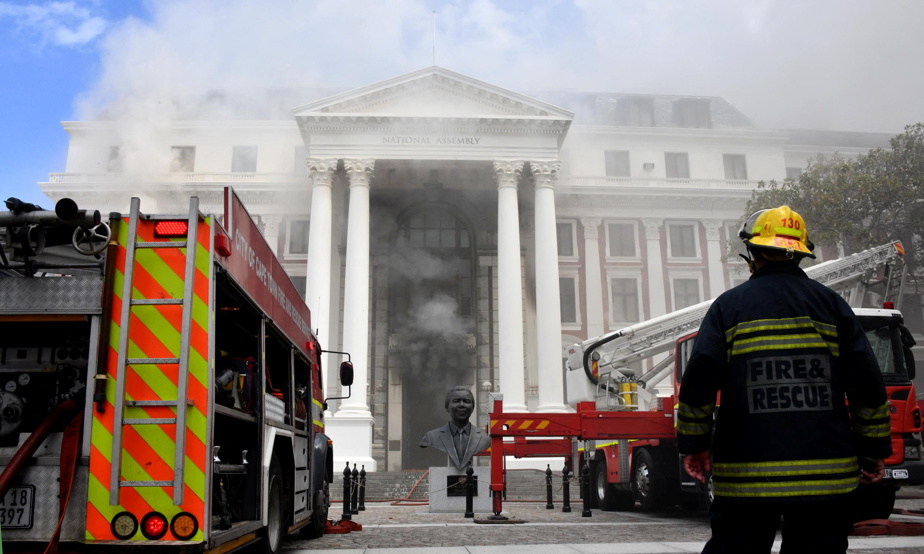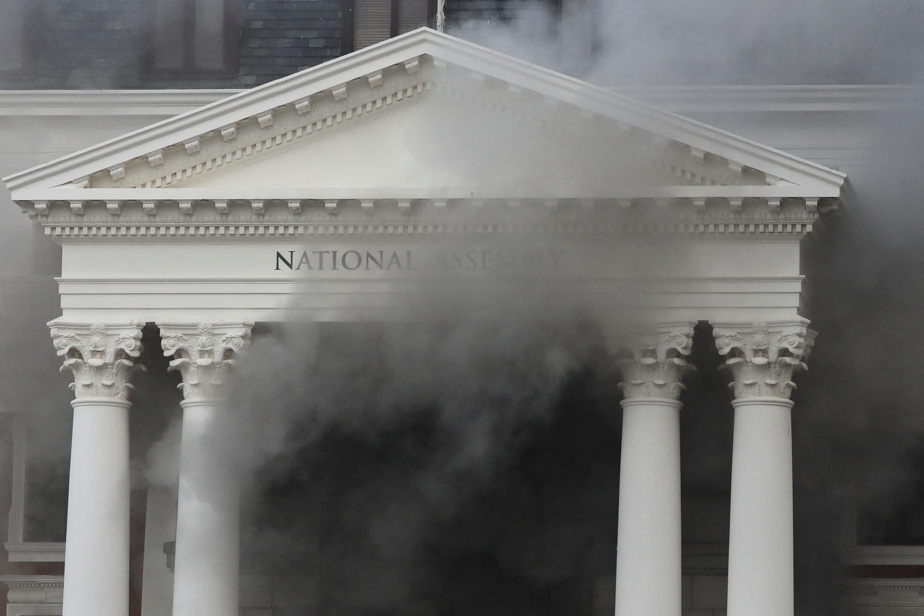(Cape Town) Dozens of firefighters fought back all day, but on Sunday, after dark, the violent blaze that devastated much of South Africa’s parliament in Cape Town and for which a suspect was arrested was not brought under control.
All day long, thick clouds of black smoke covered the historic building with a white and red Victorian facade, known to all South Africans. Flames rose from the rooftops, but no injuries were reported.
It is scheduled to meet the heads of the parliament and the government on Monday to determine the extent of the disaster. But already, the National Assembly was completely destroyed: “The roof has collapsed. The fire was so intense in this part of the building that firefighters had to evacuate to avoid any danger,” said parliament spokesman Moloto Muthabu.
He added that MPs returning from recess this Australian summer would not be able to debate in their usual leather seats, which may have been smoky for “a long time”.
But “Parliament will continue its work,” said President Cyril Ramaphosa, who visited the site in the afternoon. He himself was to address the nation there in February.

Photo ELMOND JIYANE/GCIS, via Reuters
Throughout the day, thick clouds of black smoke covered the historic building with its white and red brick Victorian facade.
The fire started at about 5 a.m. (3 a.m. GMT) in the building’s oldest wing, completed in 1884, which once housed deputies in its rooms with walls covered with precious wood. The newest parts were built in 1920 and 1980.
In this historic part, the roof was burned, “nothing was left,” according to the city’s head of emergency services, Jean-Pierre Smith. And in these old rooms decorated with carpets and curtains, the flames continued to spread at the end of the day.
Threatened Treasures
This is where Parliament kept its treasures, and some 4,000 works of art and heritage, some dating back to the 17th centurye a century. Among them, Kiskama Fabric, named after a river in the southeast of the country. The precious coin is 120 meters long and traces the history of South Africa from the first indigenous peoples, the San, to the 1994 democratic elections.
Cape Town Mayor Gordon Hill Lewis said the library, which houses a unique collection of books, has not been affected.
More than 70 firefighters were on standby at the end of the day. Heavy rain of gray ash fell inside buildings from roofs to floors littered with debris.
Police said a man in his fifties was arrested while he was in Parliament at the time of the fire. He is due to appear in court on Tuesday and criminal investigation investigators are exploring.
According to the first elements, the fire broke out in two houses. Cutting off the water supply also prevented the automatic fire extinguishing system from working properly. A report must be submitted to the President within 24 hours.
And in the upscale neighborhood, the streets have been cordoned off since dawn. The security cordon extends to the flowers still dotted on the front yard of neighboring St. George’s Cathedral, where the funeral of Desmond Tutu, the last hero in the fight against apartheid who died on December 26, was held the day before.
Cape Town has been the seat of Parliament since 1910, consisting of the National Assembly and an upper house called the National Council of Provinces, while the seat of government is in Pretoria.
In February 1990 the last white president of South Africa who died in November, FW de Klerk, announced there about the end of apartheid.
The building was already the victim of a quickly contained fire in March. And in April, a fire engulfed Table Mountain overlooking the coastal city and destroyed the treasures of the library at the prestigious University of Cape Town.

“Extreme twitteraholic. Passionate travel nerd. Hardcore zombie trailblazer. Web fanatic. Evil bacon geek.”


